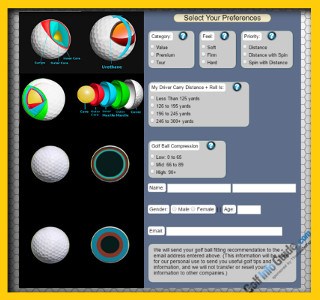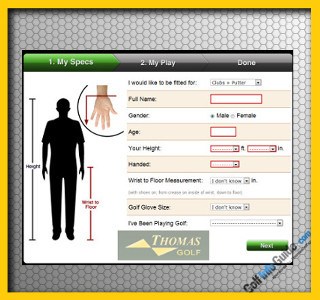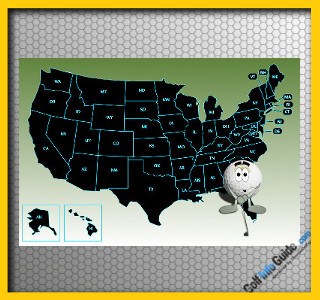- On the first screen, you'll identify where you'd like help: Swing Faults, Swing Improvements, Setup and Address, Short Game or Mental Side.
- Screen 2 will present a menu of options based on your screen 1 selection. For example, say you chose Swing Faults to begin. Now pick your specific ailment: Slice, Hook, Pull, Push and so on.
- On the third screen, you'll be prompted to choose the best description of your issue. For example, “I'm a new golfer with a slice,” or, “I'm looking for a good drill to work on my hook problem.”
- The next screen lets you continue by choosing another topic from the original menu, or end the process and receive your tips.
- Once finished, just enter your name, gender, age, hand (right or left) and email address. Within seconds, we'll send you a link to a page with one or more video lessons specifically geared to your needs.
- Convenience. Going through a club fitting is something that you could easily put of for weeks or months simply because you are too busy with ‘real life’. If you don’t have time to get to the course to go through the fitting, it may not ever get done. Not only do you have to have the time in your schedule for the fitting, you also have to be available at a time that works for the fitting professional at your local club. Additionally, you may have to do the fitting during a time that you would normally be playing golf, meaning you will miss out on a round in the process. With online club fitting, time is not nearly the same kind of hurdle. In fact, you could probably have the process completed by the time you are finished reading this article.
- Honesty. It can be hard to be honest when you are going through a fitting in person – that’s just the truth of the matter. When the club fitter asks you about your average score, what do you say? Do you tell them the complete truth, or do you make yourself sound like a better player than you actually are? Well all have an ego, and it is tempting to present the best possible version of yourself to the person that you are working with on the fitting. Of course, when you do the fitting online, that issue will be a non-factor. You will only be filling in fields on a web page, so you won’t be as compelled to ‘fugde’ the numbers. You can be completely honest – meaning you are far more likely to get accurate information in return.
- Ordering online. Many golfers choose to buy their clubs online these days, for obvious reasons. Shopping online offers greater convenience than shopping in person, and you can also shop around to get a great deal on the gear that you wish to own. Therefore, by going through an online golf club fitting, you will have all of the information you need right there in front of you when you are ready to place an order. Not sure what shaft flex you need, or how long you should order your irons? You will have those answers in just a matter of minutes if you take the step of completing an online fitting form.
- They all hit 300 yards drives. There are certainly some players on the PGA Tour who hit the ball incredible distances. Players like Dustin Johnson and Bubba Watson are noted for their ability to hit the ball huge distances, both off the tee and from the fairway. However, those players do not necessarily represent the majority on Tour. It requires a wide-range of skills to reach the top of the game of golf, and power is only one of the elements at play. A larger number of Tour players actually hit the ball relatively modest distances, yet are able to compete because of incredible accuracy and polished short games. As you work on your own game, don’t think that you have to work your way up to 300 yards off the tee – as the players on the Tour prove, you don’t have to own a powerful swing to be a great golfer.
- They never hit bad shots. Pro golfers hit bad shots in every single round that they play. Part of this misconception is the distorted reality presented by watching golf on TV. It is important to remember that while you are watching golf on TV, the broadcast is only showing you the best of the best. The TV cameras follow the leaders of the tournament, who are obviously the players performing at the top of their games. When you watch on TV, you might get the impression that pros never get off track or make a bad swing. If you get the chance, visit a Tour event in person and follow a specific group around for the day. After this experience, you will realize that while PGA Tour players are great at what they do, they aren’t perfect.
- They just show up Thursday morning and get started. There is an incredible amount of preparation that goes into each professional event – especially the majors. In order for a professional golfer to be successful, they need to be fully committed to the process of shooting good scores. That means spending long hours early in the week learning the golf course and developing a game plan. When the tournament actually starts on Thursday, the players have already put in plenty of time getting ready to perform. It might seem like a dream job to play golf for a living, but make no mistake – there is plenty of hard work required to make that dream a reality.

Just answer a few basic questions and in a matter of seconds, video tips from a professional golf teacher will pop into your inbox.
Here's how it works:

2. Free Golf Ball Fitting Chart
Our Golf Ball Fitting Guide will take you through the selection process step by step, using your skills and personal preferences to determine which ball is your best bet. In this section, you'll also find an ever-expanding menu of reviews detailing the performance traits of today's brand-name and lesser-known golf balls.

3. Free Online Golf Club Fitting
Following are three elements of online club fitting that should have you strongly considering this option.
It is true that an online fitting isn’t going to be able to quite offer you the same level of detail and accuracy that you could get from an in-person fitting with a qualified professional. However, if you wish to save both time and money while giving yourself a good chance to get clubs that fit your swing, an online process can be greatly beneficial.

4. Free Online Golf Video Search
The PGA pro golf videos will tackle general topics such as the shoulder turn and swing tempo, while offering specific drills to practice at home or on the range. Their demonstrations will provide visual cues to help you better understand each lesson, and all videos will include a transcript.
We’ll keep the golf videos lessons short and sweet, but with plenty of need-to-know information to guide you toward a better golf game. Check out the current list of lessons below; a single click takes you to the video and transcript of your chosen topic.

5. USA Golf Course Search and Reviews
Learning the basics of golf is not really difficult for you to do. It only takes time before you really get to the level where you can see yourself playing on a full golf course. In the beginning, you will have to spend time practicing on a driving range before stepping onto a full golf course. The top golf courses in America have better driving range areas where beginners and even veteran golfers can practice their strokes to develop different sets of skills needed to play golf professionally.
As you improve, you may begin with a shorter course such as an executive golf course where the distance between the tee area and the hole is only around 250 yards. This will enable you to apply what you have developed in a driving range and experience the game with less difficulty. You can find public golf courses like these in a variety of spots. In the long run, you may try looking for an exclusive membership to a much more difficult golf course.
While developing your skills on short golf courses, you can increase your knowledge in reading some primers and written instructions on how to play golf. A golf course guide will help you understand some more advanced techniques that you can also develop through practice. By reading more instructional materials, it will become easier for you to practice and develop your skills. And through practice, it makes it easier for you to understand the techniques behind the game.

6. Calculate Your Handicap Online Free
Beyond competition, keeping a handicap allows you to set goals and track your progress (or lack thereof). Improving skills should lead to lower scores, dropping your handicap.
In short, anyone who plays regularly – say, a minimum of once per month – should definitely record all their scores and monitor their handicap. Golf-Info-Guide.com makes it easy with our simple handicap tracking tool.
In the spaces provided, enter the course rating and slope rating of the course and tees you played; these figures should be listed on the scorecard. If not, consult the USGA’s Course & Slope Rating Database for U.S. courses. Elsewhere, your national golf association (e.g., Golf Australia or Golf Canada) should provide a similar listing.
Next, enter your adjusted gross score for 18 holes. Once you’ve entered five scores, the calculator will provide your handicap index, which will fluctuate with each new score entered. Your handicap is based on a maximum of your 20 most recent scores. Once you’ve entered 20, the next score will bump your oldest one from the table, and so on.
With our calculator, you can also compute your personal course handicap for a specific course by simply entering the slope rating. The higher the slope, the more difficult the course and the higher your course handicap. When playing the course, this is the number used to determine how many strokes you get (or give) in competition.

Following are three ‘myths’ regarding PGA Tour players –

8. Online Golf Questions and Answers Search
Here in the online golf, Questions and Answers section of Golf-Info-Guide.com, you’ll find easily searched, simply phrased topics explaining – in clear language – the hows, whats and whys of the swing, the techniques for playing different shots, the causes behind your faulty attempts and, of course, the advice and cures for whatever ails you.
In this ever-expanding online golf section, our pros field a host of common golf questions and provide the right – and wrong – answers. The responses offer in-depth explanations, solutions and tips to end confusion and make you a better player.
Some Q&A tips are geared toward the novice golfer, like “How Can I Keep My Head Down?” Others tackle issues faced by the intermediate player – for example, “How Do You Play a Three-Quarter Wedge Shot?” We’ve also got answers to the advanced golfer’s questions, such as “How Should I Hit a Lob Wedge from a Tight Lie?”





